Big Data Security
VerifiedAdded on 2023/03/23
|11
|3107
|67
AI Summary
This report discusses the security concerns associated with big data and strategies for addressing them. It covers topics such as data privacy, infrastructure security, and data management. The report concludes with future trends in big data security.
Contribute Materials
Your contribution can guide someone’s learning journey. Share your
documents today.
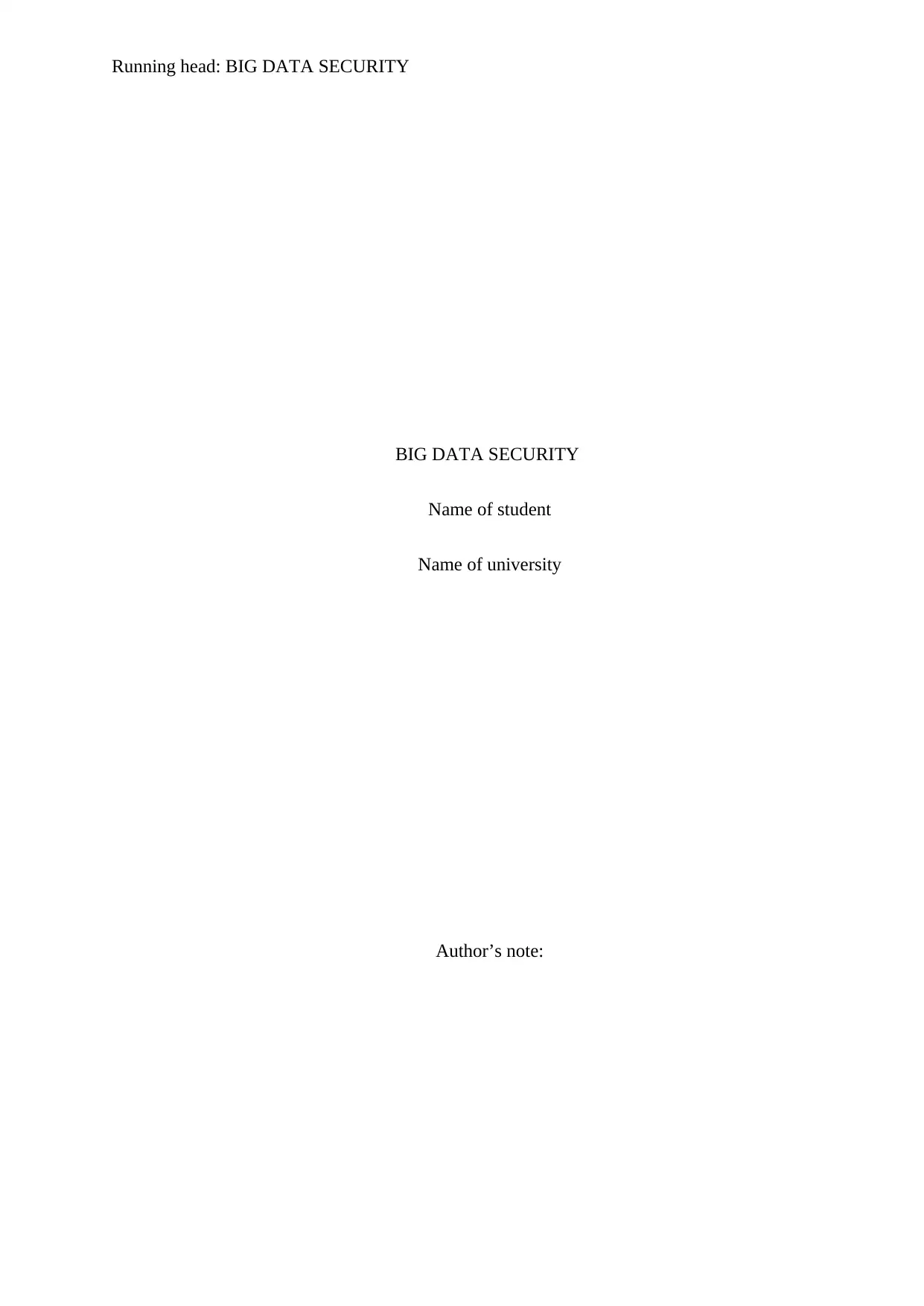
Running head: BIG DATA SECURITY
BIG DATA SECURITY
Name of student
Name of university
Author’s note:
BIG DATA SECURITY
Name of student
Name of university
Author’s note:
Secure Best Marks with AI Grader
Need help grading? Try our AI Grader for instant feedback on your assignments.
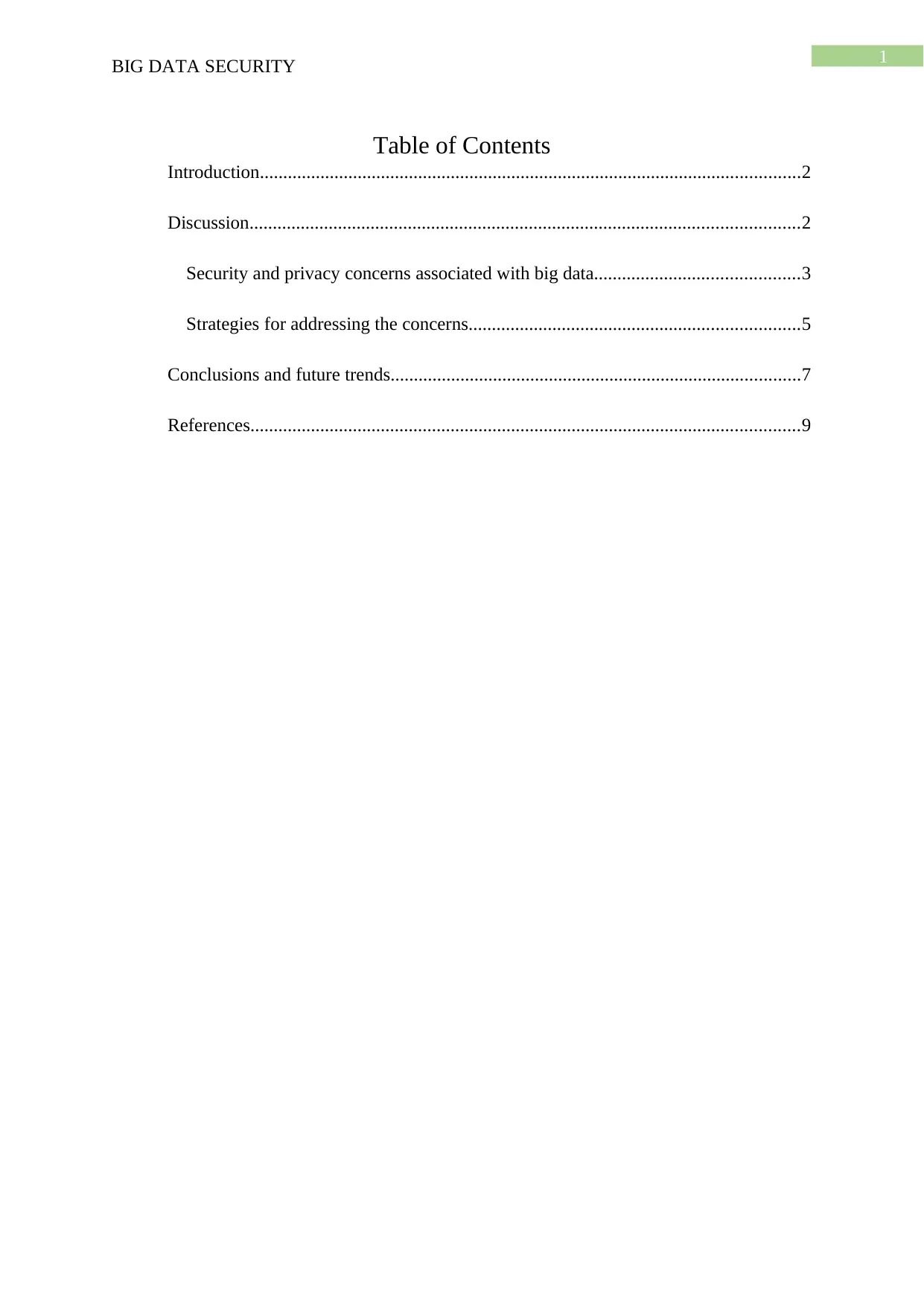
1
BIG DATA SECURITY
Table of Contents
Introduction....................................................................................................................2
Discussion......................................................................................................................2
Security and privacy concerns associated with big data............................................3
Strategies for addressing the concerns.......................................................................5
Conclusions and future trends........................................................................................7
References......................................................................................................................9
BIG DATA SECURITY
Table of Contents
Introduction....................................................................................................................2
Discussion......................................................................................................................2
Security and privacy concerns associated with big data............................................3
Strategies for addressing the concerns.......................................................................5
Conclusions and future trends........................................................................................7
References......................................................................................................................9
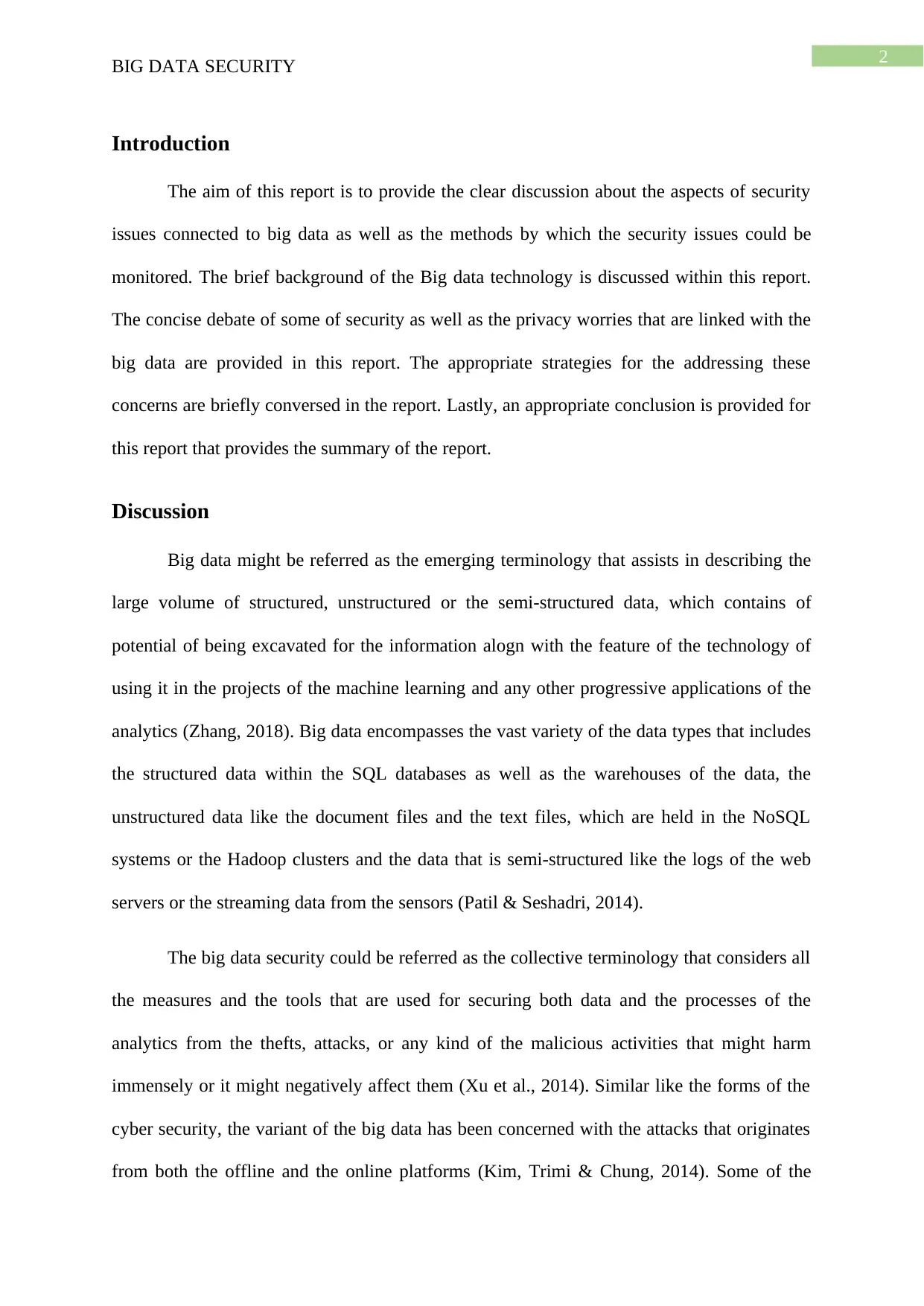
2
BIG DATA SECURITY
Introduction
The aim of this report is to provide the clear discussion about the aspects of security
issues connected to big data as well as the methods by which the security issues could be
monitored. The brief background of the Big data technology is discussed within this report.
The concise debate of some of security as well as the privacy worries that are linked with the
big data are provided in this report. The appropriate strategies for the addressing these
concerns are briefly conversed in the report. Lastly, an appropriate conclusion is provided for
this report that provides the summary of the report.
Discussion
Big data might be referred as the emerging terminology that assists in describing the
large volume of structured, unstructured or the semi-structured data, which contains of
potential of being excavated for the information alogn with the feature of the technology of
using it in the projects of the machine learning and any other progressive applications of the
analytics (Zhang, 2018). Big data encompasses the vast variety of the data types that includes
the structured data within the SQL databases as well as the warehouses of the data, the
unstructured data like the document files and the text files, which are held in the NoSQL
systems or the Hadoop clusters and the data that is semi-structured like the logs of the web
servers or the streaming data from the sensors (Patil & Seshadri, 2014).
The big data security could be referred as the collective terminology that considers all
the measures and the tools that are used for securing both data and the processes of the
analytics from the thefts, attacks, or any kind of the malicious activities that might harm
immensely or it might negatively affect them (Xu et al., 2014). Similar like the forms of the
cyber security, the variant of the big data has been concerned with the attacks that originates
from both the offline and the online platforms (Kim, Trimi & Chung, 2014). Some of the
BIG DATA SECURITY
Introduction
The aim of this report is to provide the clear discussion about the aspects of security
issues connected to big data as well as the methods by which the security issues could be
monitored. The brief background of the Big data technology is discussed within this report.
The concise debate of some of security as well as the privacy worries that are linked with the
big data are provided in this report. The appropriate strategies for the addressing these
concerns are briefly conversed in the report. Lastly, an appropriate conclusion is provided for
this report that provides the summary of the report.
Discussion
Big data might be referred as the emerging terminology that assists in describing the
large volume of structured, unstructured or the semi-structured data, which contains of
potential of being excavated for the information alogn with the feature of the technology of
using it in the projects of the machine learning and any other progressive applications of the
analytics (Zhang, 2018). Big data encompasses the vast variety of the data types that includes
the structured data within the SQL databases as well as the warehouses of the data, the
unstructured data like the document files and the text files, which are held in the NoSQL
systems or the Hadoop clusters and the data that is semi-structured like the logs of the web
servers or the streaming data from the sensors (Patil & Seshadri, 2014).
The big data security could be referred as the collective terminology that considers all
the measures and the tools that are used for securing both data and the processes of the
analytics from the thefts, attacks, or any kind of the malicious activities that might harm
immensely or it might negatively affect them (Xu et al., 2014). Similar like the forms of the
cyber security, the variant of the big data has been concerned with the attacks that originates
from both the offline and the online platforms (Kim, Trimi & Chung, 2014). Some of the
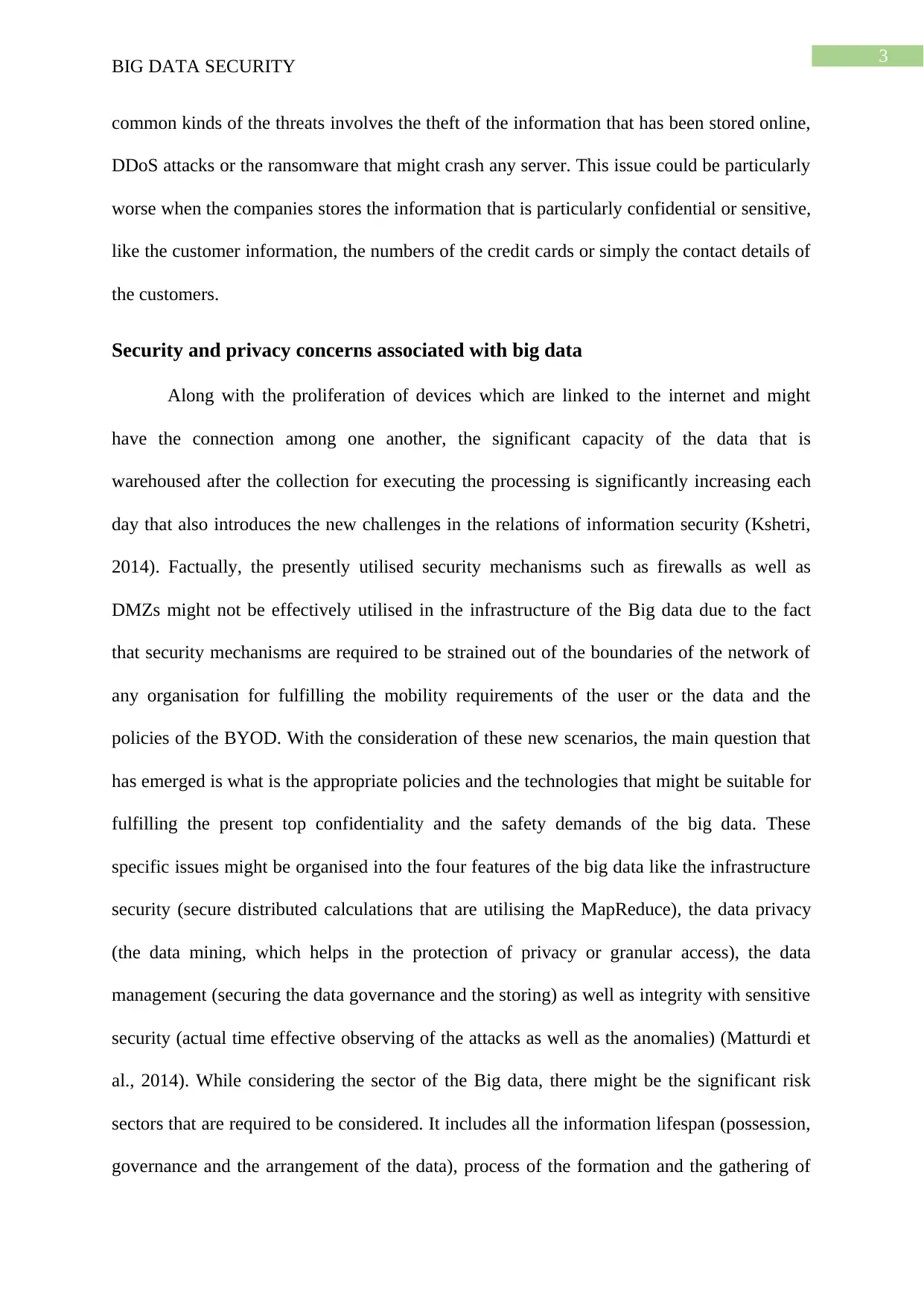
3
BIG DATA SECURITY
common kinds of the threats involves the theft of the information that has been stored online,
DDoS attacks or the ransomware that might crash any server. This issue could be particularly
worse when the companies stores the information that is particularly confidential or sensitive,
like the customer information, the numbers of the credit cards or simply the contact details of
the customers.
Security and privacy concerns associated with big data
Along with the proliferation of devices which are linked to the internet and might
have the connection among one another, the significant capacity of the data that is
warehoused after the collection for executing the processing is significantly increasing each
day that also introduces the new challenges in the relations of information security (Kshetri,
2014). Factually, the presently utilised security mechanisms such as firewalls as well as
DMZs might not be effectively utilised in the infrastructure of the Big data due to the fact
that security mechanisms are required to be strained out of the boundaries of the network of
any organisation for fulfilling the mobility requirements of the user or the data and the
policies of the BYOD. With the consideration of these new scenarios, the main question that
has emerged is what is the appropriate policies and the technologies that might be suitable for
fulfilling the present top confidentiality and the safety demands of the big data. These
specific issues might be organised into the four features of the big data like the infrastructure
security (secure distributed calculations that are utilising the MapReduce), the data privacy
(the data mining, which helps in the protection of privacy or granular access), the data
management (securing the data governance and the storing) as well as integrity with sensitive
security (actual time effective observing of the attacks as well as the anomalies) (Matturdi et
al., 2014). While considering the sector of the Big data, there might be the significant risk
sectors that are required to be considered. It includes all the information lifespan (possession,
governance and the arrangement of the data), process of the formation and the gathering of
BIG DATA SECURITY
common kinds of the threats involves the theft of the information that has been stored online,
DDoS attacks or the ransomware that might crash any server. This issue could be particularly
worse when the companies stores the information that is particularly confidential or sensitive,
like the customer information, the numbers of the credit cards or simply the contact details of
the customers.
Security and privacy concerns associated with big data
Along with the proliferation of devices which are linked to the internet and might
have the connection among one another, the significant capacity of the data that is
warehoused after the collection for executing the processing is significantly increasing each
day that also introduces the new challenges in the relations of information security (Kshetri,
2014). Factually, the presently utilised security mechanisms such as firewalls as well as
DMZs might not be effectively utilised in the infrastructure of the Big data due to the fact
that security mechanisms are required to be strained out of the boundaries of the network of
any organisation for fulfilling the mobility requirements of the user or the data and the
policies of the BYOD. With the consideration of these new scenarios, the main question that
has emerged is what is the appropriate policies and the technologies that might be suitable for
fulfilling the present top confidentiality and the safety demands of the big data. These
specific issues might be organised into the four features of the big data like the infrastructure
security (secure distributed calculations that are utilising the MapReduce), the data privacy
(the data mining, which helps in the protection of privacy or granular access), the data
management (securing the data governance and the storing) as well as integrity with sensitive
security (actual time effective observing of the attacks as well as the anomalies) (Matturdi et
al., 2014). While considering the sector of the Big data, there might be the significant risk
sectors that are required to be considered. It includes all the information lifespan (possession,
governance and the arrangement of the data), process of the formation and the gathering of
Secure Best Marks with AI Grader
Need help grading? Try our AI Grader for instant feedback on your assignments.
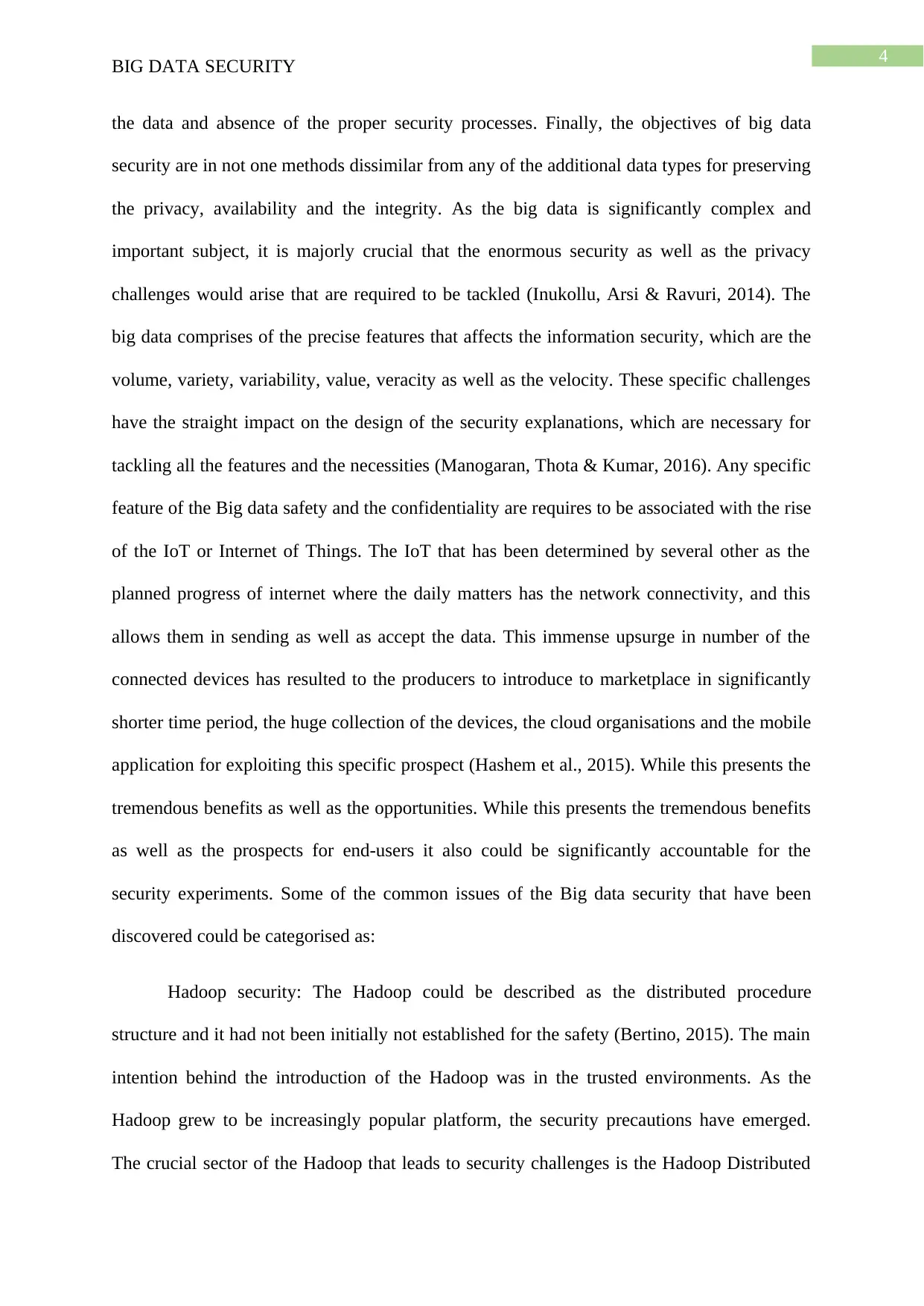
4
BIG DATA SECURITY
the data and absence of the proper security processes. Finally, the objectives of big data
security are in not one methods dissimilar from any of the additional data types for preserving
the privacy, availability and the integrity. As the big data is significantly complex and
important subject, it is majorly crucial that the enormous security as well as the privacy
challenges would arise that are required to be tackled (Inukollu, Arsi & Ravuri, 2014). The
big data comprises of the precise features that affects the information security, which are the
volume, variety, variability, value, veracity as well as the velocity. These specific challenges
have the straight impact on the design of the security explanations, which are necessary for
tackling all the features and the necessities (Manogaran, Thota & Kumar, 2016). Any specific
feature of the Big data safety and the confidentiality are requires to be associated with the rise
of the IoT or Internet of Things. The IoT that has been determined by several other as the
planned progress of internet where the daily matters has the network connectivity, and this
allows them in sending as well as accept the data. This immense upsurge in number of the
connected devices has resulted to the producers to introduce to marketplace in significantly
shorter time period, the huge collection of the devices, the cloud organisations and the mobile
application for exploiting this specific prospect (Hashem et al., 2015). While this presents the
tremendous benefits as well as the opportunities. While this presents the tremendous benefits
as well as the prospects for end-users it also could be significantly accountable for the
security experiments. Some of the common issues of the Big data security that have been
discovered could be categorised as:
Hadoop security: The Hadoop could be described as the distributed procedure
structure and it had not been initially not established for the safety (Bertino, 2015). The main
intention behind the introduction of the Hadoop was in the trusted environments. As the
Hadoop grew to be increasingly popular platform, the security precautions have emerged.
The crucial sector of the Hadoop that leads to security challenges is the Hadoop Distributed
BIG DATA SECURITY
the data and absence of the proper security processes. Finally, the objectives of big data
security are in not one methods dissimilar from any of the additional data types for preserving
the privacy, availability and the integrity. As the big data is significantly complex and
important subject, it is majorly crucial that the enormous security as well as the privacy
challenges would arise that are required to be tackled (Inukollu, Arsi & Ravuri, 2014). The
big data comprises of the precise features that affects the information security, which are the
volume, variety, variability, value, veracity as well as the velocity. These specific challenges
have the straight impact on the design of the security explanations, which are necessary for
tackling all the features and the necessities (Manogaran, Thota & Kumar, 2016). Any specific
feature of the Big data safety and the confidentiality are requires to be associated with the rise
of the IoT or Internet of Things. The IoT that has been determined by several other as the
planned progress of internet where the daily matters has the network connectivity, and this
allows them in sending as well as accept the data. This immense upsurge in number of the
connected devices has resulted to the producers to introduce to marketplace in significantly
shorter time period, the huge collection of the devices, the cloud organisations and the mobile
application for exploiting this specific prospect (Hashem et al., 2015). While this presents the
tremendous benefits as well as the opportunities. While this presents the tremendous benefits
as well as the prospects for end-users it also could be significantly accountable for the
security experiments. Some of the common issues of the Big data security that have been
discovered could be categorised as:
Hadoop security: The Hadoop could be described as the distributed procedure
structure and it had not been initially not established for the safety (Bertino, 2015). The main
intention behind the introduction of the Hadoop was in the trusted environments. As the
Hadoop grew to be increasingly popular platform, the security precautions have emerged.
The crucial sector of the Hadoop that leads to security challenges is the Hadoop Distributed
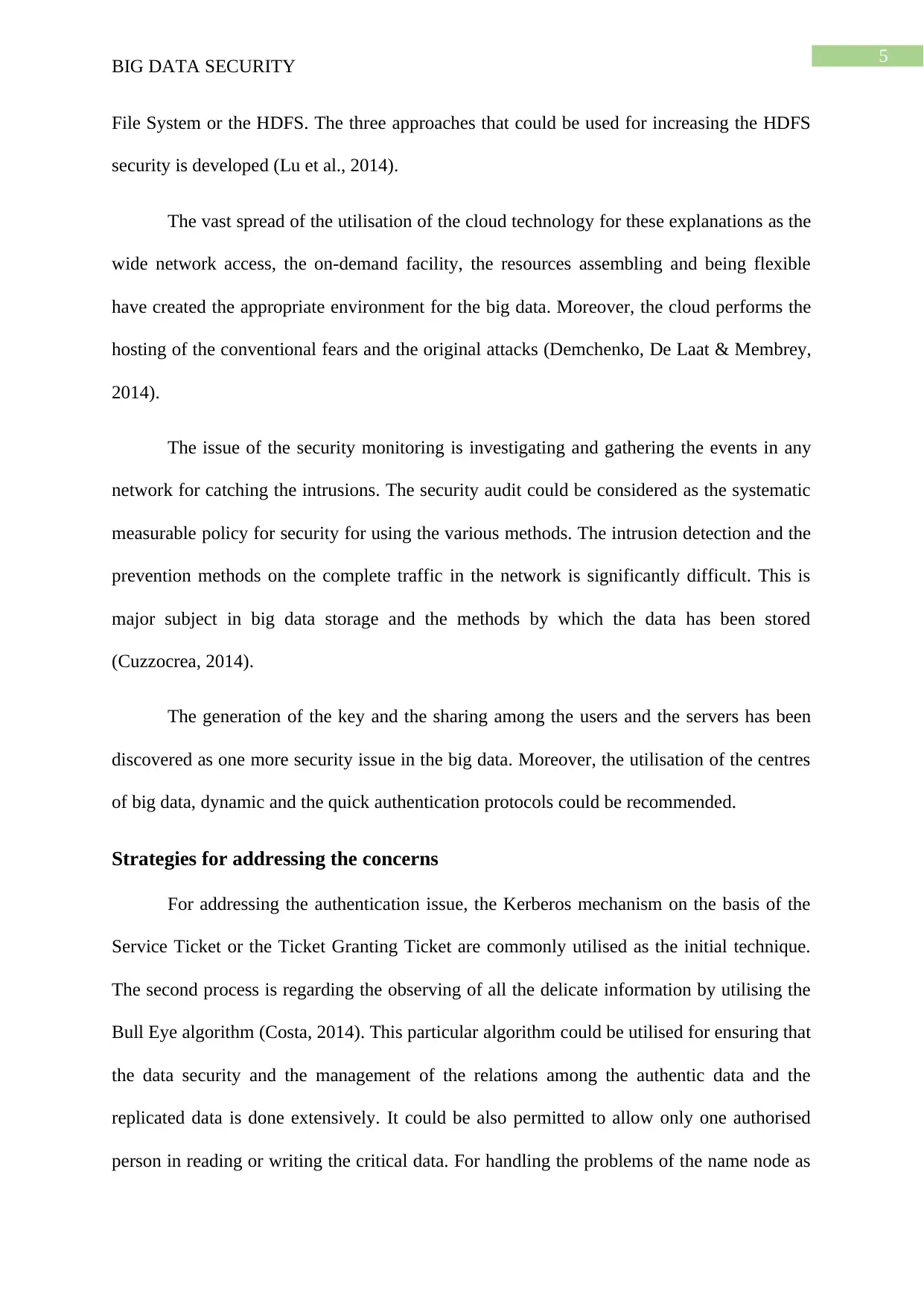
5
BIG DATA SECURITY
File System or the HDFS. The three approaches that could be used for increasing the HDFS
security is developed (Lu et al., 2014).
The vast spread of the utilisation of the cloud technology for these explanations as the
wide network access, the on-demand facility, the resources assembling and being flexible
have created the appropriate environment for the big data. Moreover, the cloud performs the
hosting of the conventional fears and the original attacks (Demchenko, De Laat & Membrey,
2014).
The issue of the security monitoring is investigating and gathering the events in any
network for catching the intrusions. The security audit could be considered as the systematic
measurable policy for security for using the various methods. The intrusion detection and the
prevention methods on the complete traffic in the network is significantly difficult. This is
major subject in big data storage and the methods by which the data has been stored
(Cuzzocrea, 2014).
The generation of the key and the sharing among the users and the servers has been
discovered as one more security issue in the big data. Moreover, the utilisation of the centres
of big data, dynamic and the quick authentication protocols could be recommended.
Strategies for addressing the concerns
For addressing the authentication issue, the Kerberos mechanism on the basis of the
Service Ticket or the Ticket Granting Ticket are commonly utilised as the initial technique.
The second process is regarding the observing of all the delicate information by utilising the
Bull Eye algorithm (Costa, 2014). This particular algorithm could be utilised for ensuring that
the data security and the management of the relations among the authentic data and the
replicated data is done extensively. It could be also permitted to allow only one authorised
person in reading or writing the critical data. For handling the problems of the name node as
BIG DATA SECURITY
File System or the HDFS. The three approaches that could be used for increasing the HDFS
security is developed (Lu et al., 2014).
The vast spread of the utilisation of the cloud technology for these explanations as the
wide network access, the on-demand facility, the resources assembling and being flexible
have created the appropriate environment for the big data. Moreover, the cloud performs the
hosting of the conventional fears and the original attacks (Demchenko, De Laat & Membrey,
2014).
The issue of the security monitoring is investigating and gathering the events in any
network for catching the intrusions. The security audit could be considered as the systematic
measurable policy for security for using the various methods. The intrusion detection and the
prevention methods on the complete traffic in the network is significantly difficult. This is
major subject in big data storage and the methods by which the data has been stored
(Cuzzocrea, 2014).
The generation of the key and the sharing among the users and the servers has been
discovered as one more security issue in the big data. Moreover, the utilisation of the centres
of big data, dynamic and the quick authentication protocols could be recommended.
Strategies for addressing the concerns
For addressing the authentication issue, the Kerberos mechanism on the basis of the
Service Ticket or the Ticket Granting Ticket are commonly utilised as the initial technique.
The second process is regarding the observing of all the delicate information by utilising the
Bull Eye algorithm (Costa, 2014). This particular algorithm could be utilised for ensuring that
the data security and the management of the relations among the authentic data and the
replicated data is done extensively. It could be also permitted to allow only one authorised
person in reading or writing the critical data. For handling the problems of the name node as
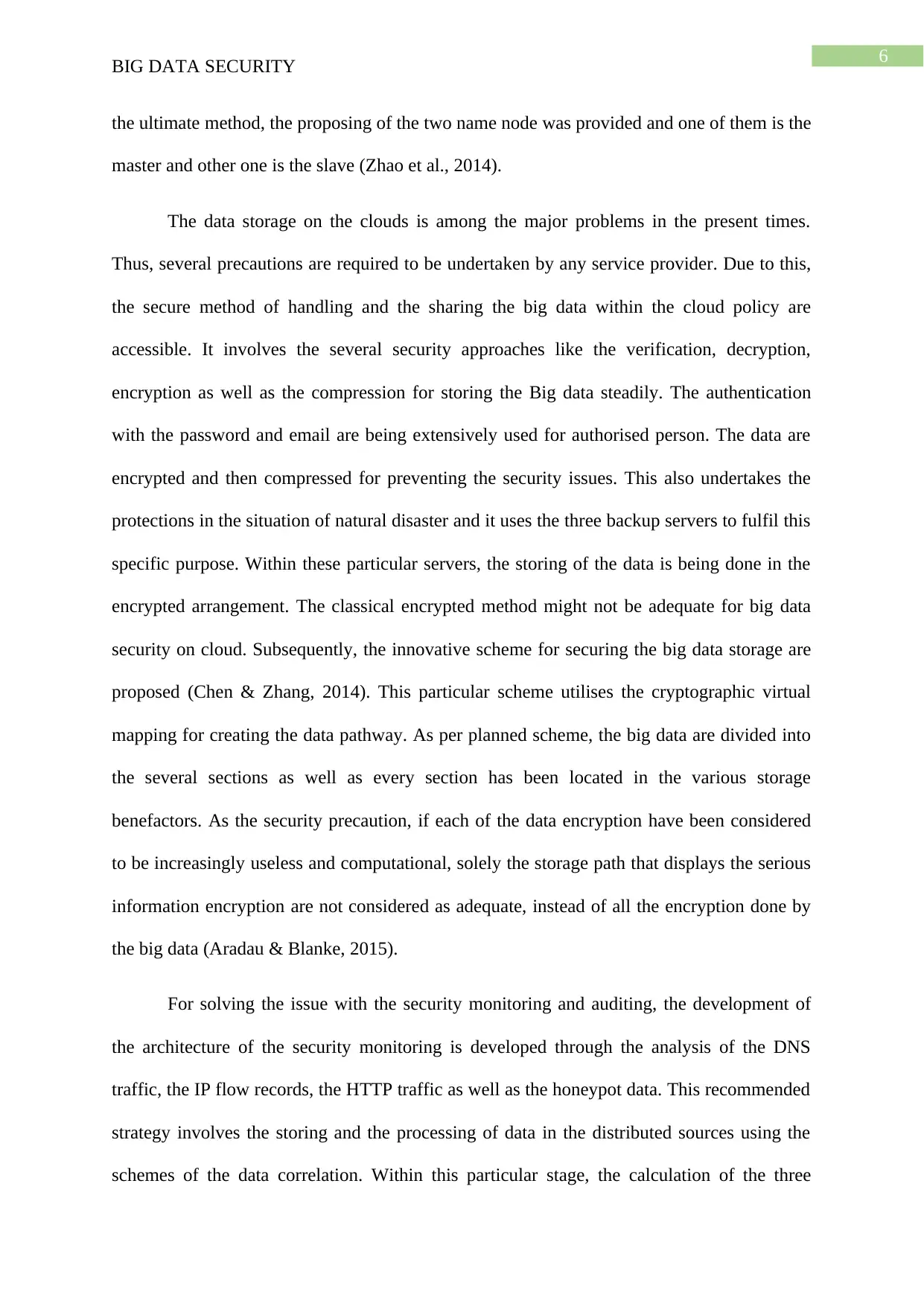
6
BIG DATA SECURITY
the ultimate method, the proposing of the two name node was provided and one of them is the
master and other one is the slave (Zhao et al., 2014).
The data storage on the clouds is among the major problems in the present times.
Thus, several precautions are required to be undertaken by any service provider. Due to this,
the secure method of handling and the sharing the big data within the cloud policy are
accessible. It involves the several security approaches like the verification, decryption,
encryption as well as the compression for storing the Big data steadily. The authentication
with the password and email are being extensively used for authorised person. The data are
encrypted and then compressed for preventing the security issues. This also undertakes the
protections in the situation of natural disaster and it uses the three backup servers to fulfil this
specific purpose. Within these particular servers, the storing of the data is being done in the
encrypted arrangement. The classical encrypted method might not be adequate for big data
security on cloud. Subsequently, the innovative scheme for securing the big data storage are
proposed (Chen & Zhang, 2014). This particular scheme utilises the cryptographic virtual
mapping for creating the data pathway. As per planned scheme, the big data are divided into
the several sections as well as every section has been located in the various storage
benefactors. As the security precaution, if each of the data encryption have been considered
to be increasingly useless and computational, solely the storage path that displays the serious
information encryption are not considered as adequate, instead of all the encryption done by
the big data (Aradau & Blanke, 2015).
For solving the issue with the security monitoring and auditing, the development of
the architecture of the security monitoring is developed through the analysis of the DNS
traffic, the IP flow records, the HTTP traffic as well as the honeypot data. This recommended
strategy involves the storing and the processing of data in the distributed sources using the
schemes of the data correlation. Within this particular stage, the calculation of the three
BIG DATA SECURITY
the ultimate method, the proposing of the two name node was provided and one of them is the
master and other one is the slave (Zhao et al., 2014).
The data storage on the clouds is among the major problems in the present times.
Thus, several precautions are required to be undertaken by any service provider. Due to this,
the secure method of handling and the sharing the big data within the cloud policy are
accessible. It involves the several security approaches like the verification, decryption,
encryption as well as the compression for storing the Big data steadily. The authentication
with the password and email are being extensively used for authorised person. The data are
encrypted and then compressed for preventing the security issues. This also undertakes the
protections in the situation of natural disaster and it uses the three backup servers to fulfil this
specific purpose. Within these particular servers, the storing of the data is being done in the
encrypted arrangement. The classical encrypted method might not be adequate for big data
security on cloud. Subsequently, the innovative scheme for securing the big data storage are
proposed (Chen & Zhang, 2014). This particular scheme utilises the cryptographic virtual
mapping for creating the data pathway. As per planned scheme, the big data are divided into
the several sections as well as every section has been located in the various storage
benefactors. As the security precaution, if each of the data encryption have been considered
to be increasingly useless and computational, solely the storage path that displays the serious
information encryption are not considered as adequate, instead of all the encryption done by
the big data (Aradau & Blanke, 2015).
For solving the issue with the security monitoring and auditing, the development of
the architecture of the security monitoring is developed through the analysis of the DNS
traffic, the IP flow records, the HTTP traffic as well as the honeypot data. This recommended
strategy involves the storing and the processing of data in the distributed sources using the
schemes of the data correlation. Within this particular stage, the calculation of the three
Paraphrase This Document
Need a fresh take? Get an instant paraphrase of this document with our AI Paraphraser
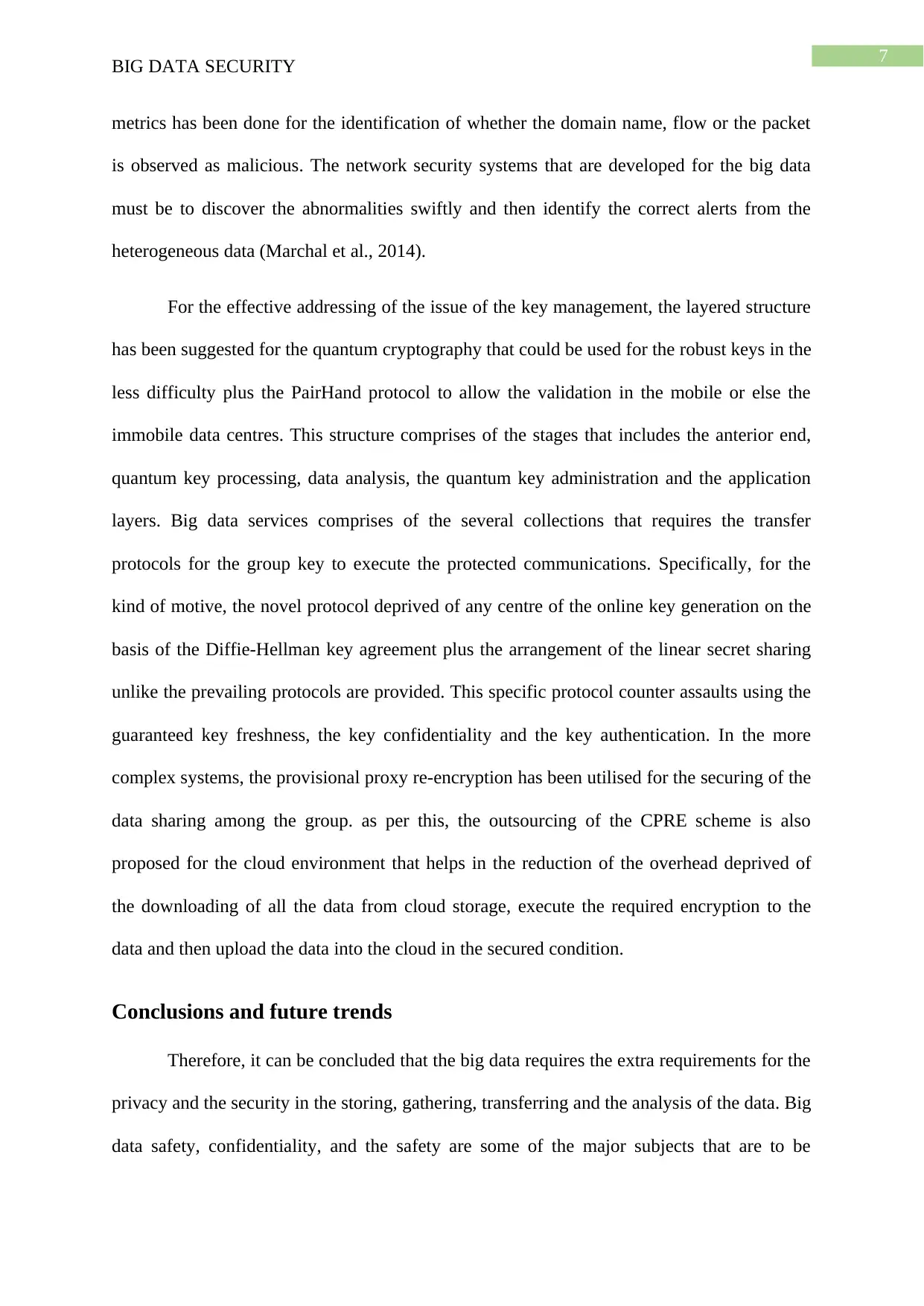
7
BIG DATA SECURITY
metrics has been done for the identification of whether the domain name, flow or the packet
is observed as malicious. The network security systems that are developed for the big data
must be to discover the abnormalities swiftly and then identify the correct alerts from the
heterogeneous data (Marchal et al., 2014).
For the effective addressing of the issue of the key management, the layered structure
has been suggested for the quantum cryptography that could be used for the robust keys in the
less difficulty plus the PairHand protocol to allow the validation in the mobile or else the
immobile data centres. This structure comprises of the stages that includes the anterior end,
quantum key processing, data analysis, the quantum key administration and the application
layers. Big data services comprises of the several collections that requires the transfer
protocols for the group key to execute the protected communications. Specifically, for the
kind of motive, the novel protocol deprived of any centre of the online key generation on the
basis of the Diffie-Hellman key agreement plus the arrangement of the linear secret sharing
unlike the prevailing protocols are provided. This specific protocol counter assaults using the
guaranteed key freshness, the key confidentiality and the key authentication. In the more
complex systems, the provisional proxy re-encryption has been utilised for the securing of the
data sharing among the group. as per this, the outsourcing of the CPRE scheme is also
proposed for the cloud environment that helps in the reduction of the overhead deprived of
the downloading of all the data from cloud storage, execute the required encryption to the
data and then upload the data into the cloud in the secured condition.
Conclusions and future trends
Therefore, it can be concluded that the big data requires the extra requirements for the
privacy and the security in the storing, gathering, transferring and the analysis of the data. Big
data safety, confidentiality, and the safety are some of the major subjects that are to be
BIG DATA SECURITY
metrics has been done for the identification of whether the domain name, flow or the packet
is observed as malicious. The network security systems that are developed for the big data
must be to discover the abnormalities swiftly and then identify the correct alerts from the
heterogeneous data (Marchal et al., 2014).
For the effective addressing of the issue of the key management, the layered structure
has been suggested for the quantum cryptography that could be used for the robust keys in the
less difficulty plus the PairHand protocol to allow the validation in the mobile or else the
immobile data centres. This structure comprises of the stages that includes the anterior end,
quantum key processing, data analysis, the quantum key administration and the application
layers. Big data services comprises of the several collections that requires the transfer
protocols for the group key to execute the protected communications. Specifically, for the
kind of motive, the novel protocol deprived of any centre of the online key generation on the
basis of the Diffie-Hellman key agreement plus the arrangement of the linear secret sharing
unlike the prevailing protocols are provided. This specific protocol counter assaults using the
guaranteed key freshness, the key confidentiality and the key authentication. In the more
complex systems, the provisional proxy re-encryption has been utilised for the securing of the
data sharing among the group. as per this, the outsourcing of the CPRE scheme is also
proposed for the cloud environment that helps in the reduction of the overhead deprived of
the downloading of all the data from cloud storage, execute the required encryption to the
data and then upload the data into the cloud in the secured condition.
Conclusions and future trends
Therefore, it can be concluded that the big data requires the extra requirements for the
privacy and the security in the storing, gathering, transferring and the analysis of the data. Big
data safety, confidentiality, and the safety are some of the major subjects that are to be

8
BIG DATA SECURITY
debated increasingly in future for allowing the original methods, tools and the answers are
required to be extensively established in the relations of the human computer interactions or
else the prevailing tools that are required to be improved for the accurate results.
BIG DATA SECURITY
debated increasingly in future for allowing the original methods, tools and the answers are
required to be extensively established in the relations of the human computer interactions or
else the prevailing tools that are required to be improved for the accurate results.
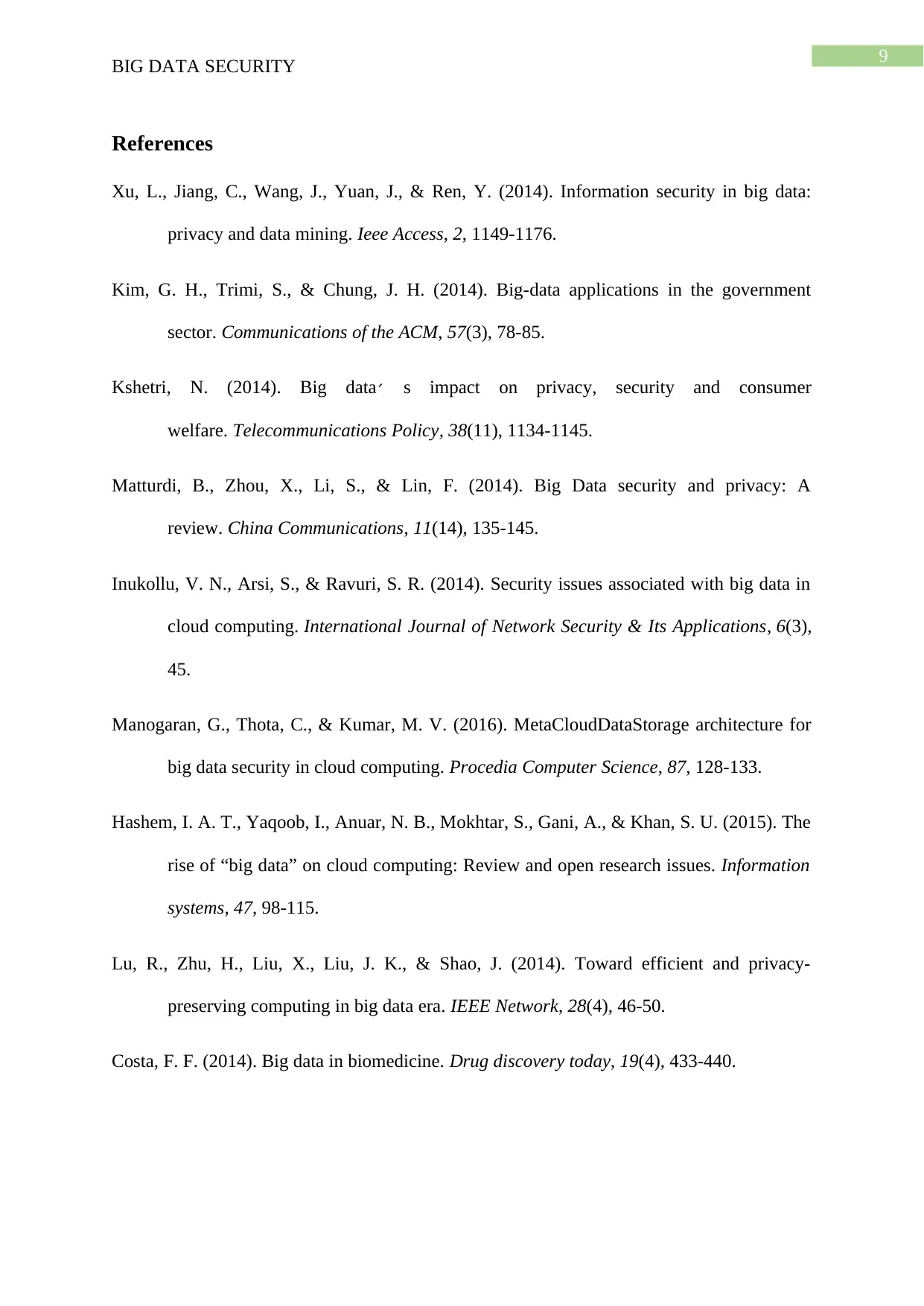
9
BIG DATA SECURITY
References
Xu, L., Jiang, C., Wang, J., Yuan, J., & Ren, Y. (2014). Information security in big data:
privacy and data mining. Ieee Access, 2, 1149-1176.
Kim, G. H., Trimi, S., & Chung, J. H. (2014). Big-data applications in the government
sector. Communications of the ACM, 57(3), 78-85.
Kshetri, N. (2014). Big data׳ s impact on privacy, security and consumer
welfare. Telecommunications Policy, 38(11), 1134-1145.
Matturdi, B., Zhou, X., Li, S., & Lin, F. (2014). Big Data security and privacy: A
review. China Communications, 11(14), 135-145.
Inukollu, V. N., Arsi, S., & Ravuri, S. R. (2014). Security issues associated with big data in
cloud computing. International Journal of Network Security & Its Applications, 6(3),
45.
Manogaran, G., Thota, C., & Kumar, M. V. (2016). MetaCloudDataStorage architecture for
big data security in cloud computing. Procedia Computer Science, 87, 128-133.
Hashem, I. A. T., Yaqoob, I., Anuar, N. B., Mokhtar, S., Gani, A., & Khan, S. U. (2015). The
rise of “big data” on cloud computing: Review and open research issues. Information
systems, 47, 98-115.
Lu, R., Zhu, H., Liu, X., Liu, J. K., & Shao, J. (2014). Toward efficient and privacy-
preserving computing in big data era. IEEE Network, 28(4), 46-50.
Costa, F. F. (2014). Big data in biomedicine. Drug discovery today, 19(4), 433-440.
BIG DATA SECURITY
References
Xu, L., Jiang, C., Wang, J., Yuan, J., & Ren, Y. (2014). Information security in big data:
privacy and data mining. Ieee Access, 2, 1149-1176.
Kim, G. H., Trimi, S., & Chung, J. H. (2014). Big-data applications in the government
sector. Communications of the ACM, 57(3), 78-85.
Kshetri, N. (2014). Big data׳ s impact on privacy, security and consumer
welfare. Telecommunications Policy, 38(11), 1134-1145.
Matturdi, B., Zhou, X., Li, S., & Lin, F. (2014). Big Data security and privacy: A
review. China Communications, 11(14), 135-145.
Inukollu, V. N., Arsi, S., & Ravuri, S. R. (2014). Security issues associated with big data in
cloud computing. International Journal of Network Security & Its Applications, 6(3),
45.
Manogaran, G., Thota, C., & Kumar, M. V. (2016). MetaCloudDataStorage architecture for
big data security in cloud computing. Procedia Computer Science, 87, 128-133.
Hashem, I. A. T., Yaqoob, I., Anuar, N. B., Mokhtar, S., Gani, A., & Khan, S. U. (2015). The
rise of “big data” on cloud computing: Review and open research issues. Information
systems, 47, 98-115.
Lu, R., Zhu, H., Liu, X., Liu, J. K., & Shao, J. (2014). Toward efficient and privacy-
preserving computing in big data era. IEEE Network, 28(4), 46-50.
Costa, F. F. (2014). Big data in biomedicine. Drug discovery today, 19(4), 433-440.
Secure Best Marks with AI Grader
Need help grading? Try our AI Grader for instant feedback on your assignments.

10
BIG DATA SECURITY
Zhao, J., Wang, L., Tao, J., Chen, J., Sun, W., Ranjan, R., ... & Georgakopoulos, D. (2014).
A security framework in G-Hadoop for big data computing across distributed Cloud
data centres. Journal of Computer and System Sciences, 80(5), 994-1007.
Chen, C. P., & Zhang, C. Y. (2014). Data-intensive applications, challenges, techniques and
technologies: A survey on Big Data. Information sciences, 275, 314-347.
Aradau, C., & Blanke, T. (2015). The (Big) Data-security assemblage: Knowledge and
critique. Big Data & Society, 2(2), 2053951715609066.
Demchenko, Y., De Laat, C., & Membrey, P. (2014, May). Defining architecture components
of the Big Data Ecosystem. In 2014 International Conference on Collaboration
Technologies and Systems (CTS) (pp. 104-112). IEEE.
Patil, H. K., & Seshadri, R. (2014, June). Big data security and privacy issues in healthcare.
In 2014 IEEE international congress on big data (pp. 762-765). IEEE.
Marchal, S., Jiang, X., State, R., & Engel, T. (2014, June). A big data architecture for large
scale security monitoring. In 2014 IEEE International Congress on Big Data (pp. 56-
63). IEEE.
Cuzzocrea, A. (2014, November). Privacy and security of big data: current challenges and
future research perspectives. In Proceedings of the First International Workshop on
Privacy and Secuirty of Big Data (pp. 45-47). ACM.
Bertino, E. (2015, June). Big data-security and privacy. In 2015 IEEE International Congress
on Big Data (pp. 757-761). IEEE.
Zhang, D. (2018, October). Big data security and privacy protection. In 8th International
Conference on Management and Computer Science (ICMCS 2018). Atlantis Press.
BIG DATA SECURITY
Zhao, J., Wang, L., Tao, J., Chen, J., Sun, W., Ranjan, R., ... & Georgakopoulos, D. (2014).
A security framework in G-Hadoop for big data computing across distributed Cloud
data centres. Journal of Computer and System Sciences, 80(5), 994-1007.
Chen, C. P., & Zhang, C. Y. (2014). Data-intensive applications, challenges, techniques and
technologies: A survey on Big Data. Information sciences, 275, 314-347.
Aradau, C., & Blanke, T. (2015). The (Big) Data-security assemblage: Knowledge and
critique. Big Data & Society, 2(2), 2053951715609066.
Demchenko, Y., De Laat, C., & Membrey, P. (2014, May). Defining architecture components
of the Big Data Ecosystem. In 2014 International Conference on Collaboration
Technologies and Systems (CTS) (pp. 104-112). IEEE.
Patil, H. K., & Seshadri, R. (2014, June). Big data security and privacy issues in healthcare.
In 2014 IEEE international congress on big data (pp. 762-765). IEEE.
Marchal, S., Jiang, X., State, R., & Engel, T. (2014, June). A big data architecture for large
scale security monitoring. In 2014 IEEE International Congress on Big Data (pp. 56-
63). IEEE.
Cuzzocrea, A. (2014, November). Privacy and security of big data: current challenges and
future research perspectives. In Proceedings of the First International Workshop on
Privacy and Secuirty of Big Data (pp. 45-47). ACM.
Bertino, E. (2015, June). Big data-security and privacy. In 2015 IEEE International Congress
on Big Data (pp. 757-761). IEEE.
Zhang, D. (2018, October). Big data security and privacy protection. In 8th International
Conference on Management and Computer Science (ICMCS 2018). Atlantis Press.
1 out of 11
Related Documents
Your All-in-One AI-Powered Toolkit for Academic Success.
+13062052269
info@desklib.com
Available 24*7 on WhatsApp / Email
![[object Object]](/_next/static/media/star-bottom.7253800d.svg)
Unlock your academic potential
© 2024 | Zucol Services PVT LTD | All rights reserved.




